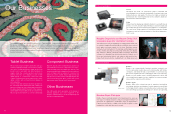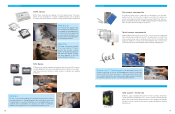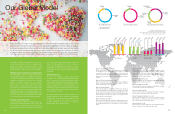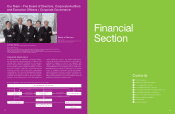Wacom 2011 Annual Report Download - page 16
Download and view the complete annual report
Please find page 16 of the 2011 Wacom annual report below. You can navigate through the pages in the report by either clicking on the pages listed below, or by using the keyword search tool below to find specific information within the annual report.
included in “Others, net” of “Net cash provided by
(used in) investing activities” in this fiscal year is
¥9,253 thousand and ¥881 thousand, respectively.
Change in accounting principles and policies for the
year ended March 31, 2011 is as follows.
(Consolidated statements of income)
The Company adopted “Cabinet Office Ordinance
Partially Revising the Regulation for Terminology,
Forms and Preparation of Financial Statements”
based on “Accounting Standard for Consolidated
Financial Statements” (Accounting Standards Board
of Japan Statement No. 22 issued on December 26,
2008) and consolidated statements of income
represent “Income before minority interest”
accordingly.
(Additional information)
The Company adopted “Accounting Standard for
Presentation of Comprehensive Income” (Accounting
Standards Board of Japan Statement No. 25 issued
on June 30, 2010). However, the amounts of
“Accumulated other comprehensive income” and
“Total accumulated other comprehensive income” for
the year ended March 31, 2010 represent the amounts
of “Valuation and translation adjustments” and “Total
valuation and translation adjustments”.
5. Consolidated balance sheets:
Information regarding consolidated balance sheets as
of March 31, 2010 and 2011 is as follows.
(1) Overdraft facility -
For effective funding to meet working capital
requirements, the Company has established overdraft
facilities with two banks. Unutilized overdraft facilities
under these contracts as of March 31, 2010 and 2011
are as follows:
6. Consolidated statements of income:
Information regarding consolidated statements of
income for the years ended March 31, 2010 and 2011
is as follows.
(1) Cost of sales -
Inventory is recorded at net realizable value.
Provisions related to inventory valuation were
recorded in cost of sales of ¥3,158 thousand and
¥28,399 thousand ($342 thousand) for the years
ended March 31, 2010 and 2011, respectively.
(2) Selling, general and administrative expenses -
The major components of “Selling, general and
administrative expenses” are as follows:
30
March 31
2011
March 31
2011
Thousands of
U.S. dollars
Thousands of yen
Amount of overdraft limit
Utilized overdraft facilities
Net amount
¥2,000,000
-
¥2,000,000
¥2,000,000
-
¥2,000,000
$24,053
-
$24,053
March 31
2010
Year ended
March 31, 2011
Year ended
March 31, 2011
Thousands of
U.S. dollars
Thousands of yen
Machinery, equipment and vehicles
Tools, furniture and fixtures
Total
¥ -
-
¥ -
¥604
604
¥1,208
$7
7
$14
Year ended
March 31, 2010
Year ended
March 31, 2011
Year ended
March 31, 2011
Thousands of
U.S. dollars
Thousands of yen
¥624
619
¥1,243
¥331
542
¥873
$4
6
$10
Year ended
March 31, 2010
Year ended
March 31, 2011
Year ended
March 31, 2011
Thousands of
U.S. dollars
Thousands of yen
Advertising expenses
Provision for allowance for
doubtful accounts
Salaries
Pension expenses
Provision for directors’ and
statutory corporate auditors’
retirement benefits
Provision for bonuses
Provision for directors’ and
statutory corporate
auditors’ bonuses
Research and development
expenses
¥1,398,410
19,474
2,932,634
160,575
34,024
267,438
33,464
1,580,173
¥1,399,112
6,053
3,018,133
126,711
9,546
231,603
31,905
1,290,576
Year ended
March 31, 2010
(3) Research and development expenditures -
Research and development expenditures are included
in selling, general and administrative expenses. Such
expenses amounted to ¥1,580,173 thousand and
¥1,290,576 thousand ($15,521 thousand) for the years
ended March 31, 2010 and 2011, respectively.
(4) Gain on sales of noncurrent assets -
(5) Loss on sales of noncurrent assets -
(6) Loss on retirement of noncurrent assets -
(7) Loss on valuation of investment securities -
Loss on valuation of investment securities is related to
the following security.
-Saitama Software Company Limited
Notes to Consolidated Financial Statements
Machinery, equipment and vehicles
Tools, furniture and fixtures
Total
March 31
2011
March 31
2011
Thousands of
U.S. dollars
Thousands of yen
¥ -
30,171
3,883
¥34,054
¥695
8,648
3,399
¥12,742
$ 8
104
41
$153
March 31
2010
Buildings and structures
Tools, furniture and fixtures
Other intangible assets
Total
$16,826
73
36,297
1,524
115
2,785
384
15,521
29
(c) Provision for directors’ and statutory corporate
auditors’ bonuses:
The provision for directors’ and statutory corporate
auditors’ bonuses is provided based on estimated
amounts expected to be paid to directors and
statutory corporate auditors.
(d) Provision for loss on disaster:
The provision for loss on disaster is provided based
on estimated expense amounts expected to occur in
the following fiscal year as a result of Tohoku Region
Pacific Coast Earthquake. These expenses include
removal or restitution expenses of assets which were
damaged by the earthquake.
(e) Provision for loss on business liquidation:
The provision for loss on business liquidation is
provided based on estimated amounts expected to
occur to prepare for the loss associated with the
withdrawal from DJ device business.
(f) Provision for retirement benefits:
The provision for retirement benefits for employees is
provided based on the actuarially calculated present
value of projected benefit obligations except for, as
permitted under the accounting standard for employ-
ees’ retirement benefits, the unrecognized actuarial
differences. The unrecognized actuarial differences
are amortized on a straight-line basis over 5 years
beginning in the year after they arise. An entire
amount of the unrecognized actuarial differences are
amortized as incurred at a part of the foreign consoli-
dated subsidiaries.
(g) Provision for directors’ and statutory corporate
auditors’ retirement benefits:
The Company had provided an accrued lump-sum
severance indemnity for directors and statutory
corporate auditors at the full amount which would
have been required to be paid if all directors and
statutory corporate auditors retired at the balance
sheet date based on the Company’s internal regula-
tions. However, we have abolished this system at the
shareholders’ meeting held on June 24, 2010 and
decided to pay the lump-sum severance indemnity
reserved so far at the time of the retirement of
directors or statutory corporate auditors.
Accordingly, provision for directors’ and statutory
corporate auditors’ retirement benefits is demolished
during the year ended March 31, 2011 and is reclassi-
fied and presented as “Others” in noncurrent liabili-
ties.
(5) Foreign currency translation -
The Company’s functional currency is Japanese yen.
The translation of assets and liabilities denominated in
foreign currency at the year-end is made at the
current exchange rate. Exchange gains and losses
resulting from foreign currency transactions and
translation of assets and liabilities denominated in
foreign currencies are included in the consolidated
statements of income. All assets, liabilities, income
and expense accounts of foreign subsidiaries are
translated using the current exchange rates at the
respective balance sheet dates. Foreign currency
translation adjustments resulting from such proce-
dures are recorded in the consolidated balance
sheets as a separate component of net assets.
(6) Amortization of goodwill -
Goodwill is amortized straight-line over the remaining
useful life.
(7) Cash and cash equivalents -
Cash and cash equivalents include all highly liquid
investments, generally with original maturities of three
months or less, those that are readily convertible to
known amounts of cash and, thus, present an
insignificant risk of changes in value.
(8) Consumption taxes -
The consumption tax withheld upon sale and
consumption tax paid by the Companies on their
purchases of goods and services is not included in
revenue and cost or expense items in the accompany-
ing consolidated statements of income.
3. Changes in accounting principles and
policies:
Change in accounting principles and policies for the
year ended March 31, 2011 is as follows.
(Accounting for asset retirement obligations)
“Accounting Standards for Asset Retirement Obliga-
tions” (Accounting Standards Board of Japan State-
ment No. 18 issued on March 31, 2008) and “Guid-
ance on Accounting Standards for Asset Retirement
Obligations” (Accounting Standards Board of Japan
Guidance No. 21 issued on March 31, 2008) have
been adopted effective for the fiscal year ended
March 31, 2011. As a result, operating income and
ordinary income decreased by ¥3,849 thousand ($46
thousand), respectively, and income before income
taxes decreased by ¥32,427 thousand ($390
thousand).
4. Changes in presentation methods:
Changes in accounting principles and policies for the
year ended March 31, 2010 were as follows.
(Consolidated balance sheets)
“Accounts receivable - other” account is separately
presented from this fiscal year, which was included in
“Others” of “Total current assets” in the previous
fiscal years, as its significance has increased. The
amount of “Accounts receivable - other” account in
the previous year is ¥897,994 thousand.
(Consolidated statements of cash flows)
“Payments for lease and guarantee deposits” account
and “Proceeds from collection of lease and guarantee
deposits” account of “Net cash provided by (used in)
investing activities” is included in “Others, net” of “Net
cash provided by (used in) investing activities” from
this fiscal year, as its significance has decreased. The
amount of “Payments for lease and guarantee
deposits” account and “Proceeds from collection of
lease and guarantee deposits” account which is






















